The Tingler
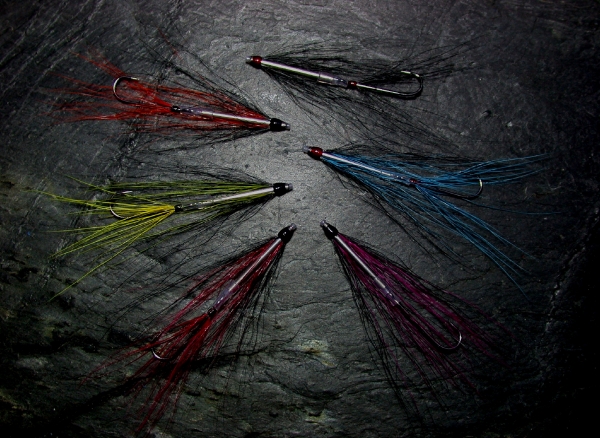
Over the years it has been
fairly standard practice to arm our sea trout tube flies
with treble hooks. While we generally dress our smaller sea
trout flies on single hooks, a small treble just looks right
on the end of a long slim tube fly. The small treble hooks
and holds on to fish pretty well, although perhaps no more
efficiently than the fly dressed on a single hook. I would
think that I have probably lost as many sea trout hooked on
trebles as on single hooked flies.
Regardless of the relative merits of
trebles versus singles or doubles, the growing focus on
catch and release, allied to increasing restrictions on
fishing methods and tackle, has seen a move away from the
use of treble hooks on our game fishing rivers. Indeed, we
are now seeing a ban on the use of treble hooks on many
fisheries, forcing many of us to seek alternatives to the
old favourites. Fortunately, there are other options and
alternatives to treble hooks are readily available. Single
hooks, designed specifically for use with tubes, are now
made by many of the major manufacturers, and, with
conservation in mind, are being increasingly widely adopted
by today’s salmon fishermen. Sea trout fishers may perhaps
be less enthusiastic and I suspect that most of us still
have a liking for a small treble on our nocturnal tube
flies. But, given the increased regulation of fishing
methods, baits and hooks, we will all have to move with the
times. I have made the first steps in the move away from
trebles by the more frequent use of single hooks on my night
sea trout tube flies and I describe here the kind of lure I
have been using increasingly over the past season or two,
with promising results. I call it the “Tingler”. It is not
by any means new, being essentially a slim tube
fly
armed with a light weight single hook, but the
name seems apt.
The single hook may be left
undressed or may be dressed as in several of the examples
illustrated here. The Tingler is intended primarily for sea
trout at night but the principle and dressing may be adapted
for any predatory fish. I think that a sparsely dressed
tube, combined with the flared dressing on the single tail
hook, creates a very fishy impression in the water. A great
benefit of the Tingler shown here is that it is extremely
simple to dress, ideal for anyone new to fly tying.
Dressing
the Tingler
Materials
A tube (I have used here a
stainless steel needle tube, diameter 1.5mm, length 20mm)
Hair for the wing (I have used
here dyed black fox squirrel tail but fine bucktail, arctic
fox or other hair may be used)
Thread
Dressing
the Tube
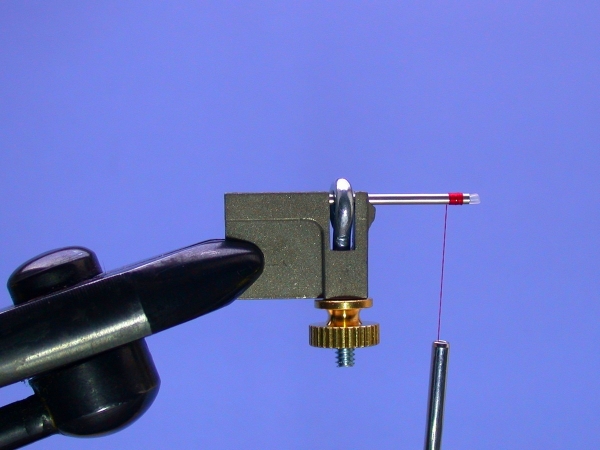
Step 1 Insert
tube in a suitable vice (I have used here the HMH Tube Fly
Starter Tool) and lay a short bed of tying thread at the
head.
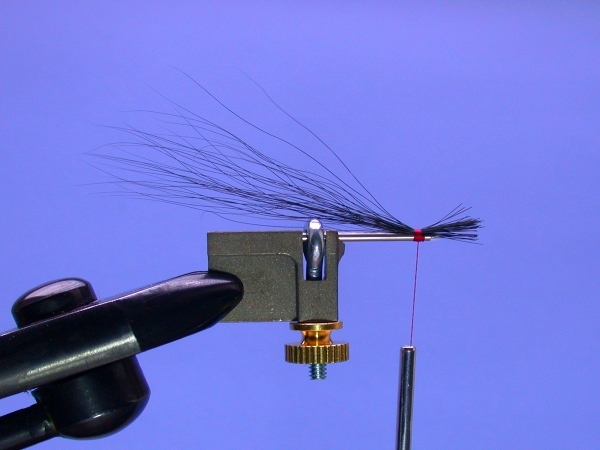
Step 2 Tie in
a sparse bunch of black squirrel tail (a few strands of
flash may be added if desired).
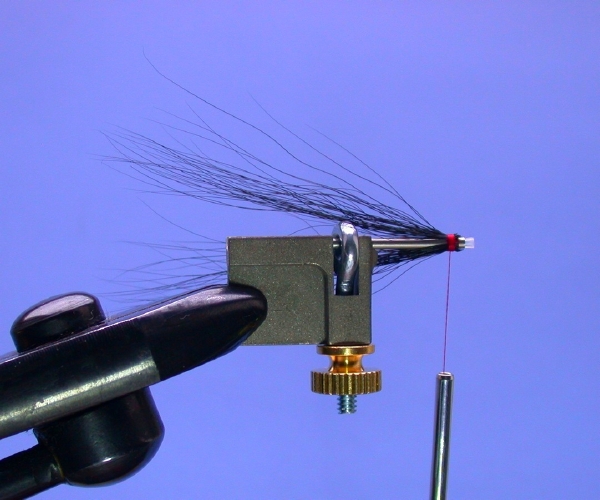
Step 3 Rotate
the tube through 180 degrees in the vice and tie in a second
bunch of squirrel tail opposite the first.
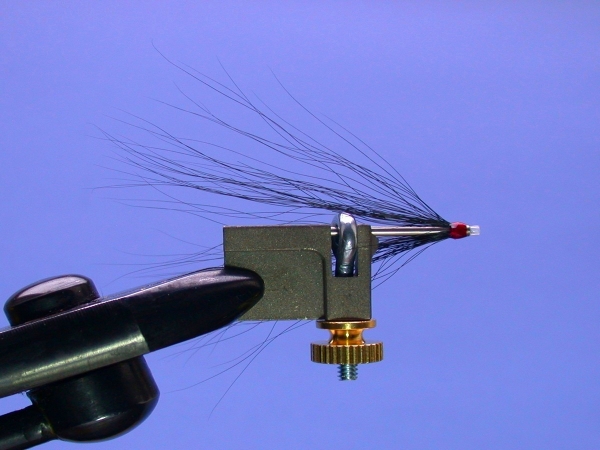
Step 4 Trim
and apply two or three coats of varnish to the head.
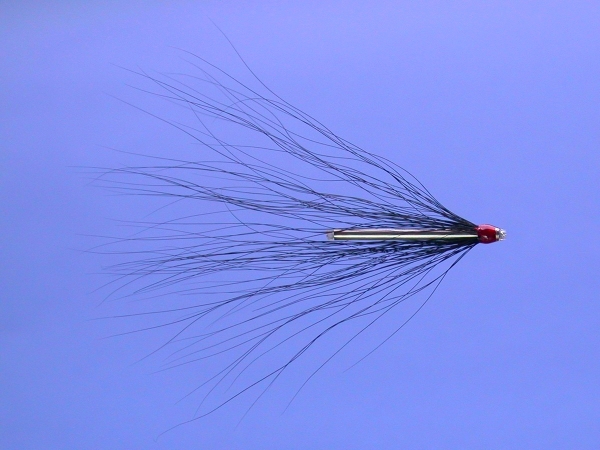
The Dressed Tube
Dressing the Hook
Repeat the dressing on a suitable
straight-eyed single hook, taking care to leave a short
length of the hook undressed at the front to insert into the
silicone sleeve on the rear of the tube fly.
I have used here a Partridge
Saltwater Perfect hook, size 8. A very similar alternative is the Mustad 3261NP-BN.
Another nice hook I have discovered recently is the
Gamakatsu G-Code F31 in size 8, which is suitable for use as
a tube hook or for dressing sea trout singles. There are many other excellent, yet
inexpensive, straight eyed single hooks available which are
suitable for use on our sea trout tubes, many of them sold
as carp hooks or coarse specimen hooks, by manufacturers
such as Kamasan, Drennan and others.
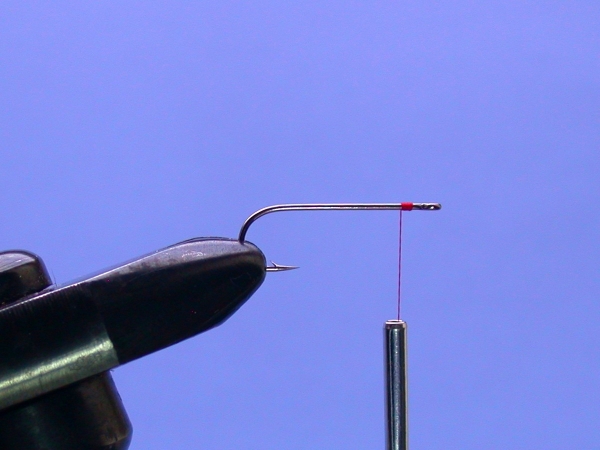
Hook Step 1
Lay a short bed of thread at the head
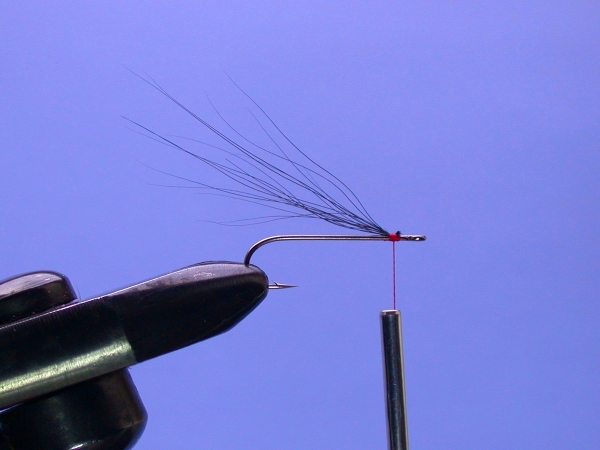
Hook Step 2 Tie in a
sparse bunch of black squirrel tail
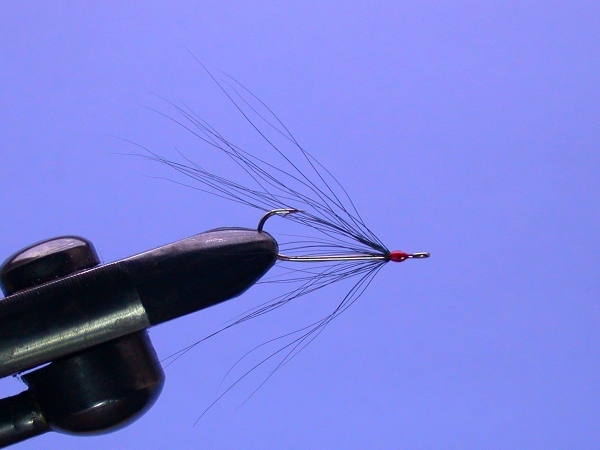
Hook Step 3
Rotate the hook through 180 degrees in the vice and tie in a
second bunch of squirrel tail opposite the first.
The tube fly may now
be armed with a dressed single hook as shown below (or with an undressed single hook).

The
assembled Tingler Tube Fly
The lure
illustrated above is a very simple tube fly, two inches
long, dressed with nothing more than black squirrel hair on
both tube and hook, possibly as effective as anything for
sea trout at night. Various colours can, of course, be used,
in addition to various flashy materials but it should be
remembered that sea trout cannot see colour at night any
more than we can. Colours will be seen merely as shades of
grey. The use of colour in our night flies can, I dare say,
do no harm, and may offer some advantage in creating a
degree of contrast and variation in tone in a lure, which
may help to provoke a response from the fish and, if
creating colourful night flies gives us as anglers a bit of
confidence, and provides some distraction and purpose to us
as fly tyers over the long winter months, then why not! A
splash of colour can also be a useful addition to flies
intended for use in daytime.
Simplicity is key, I think, both in
dressing and fishing this kind of lure for sea trout at
night. To paraphrase Falkus, the aim is to create a slim,
tenuous “impression” of a bait fish, rather than an
imitation; a tantalising reminder of their time spent
chasing sandeels in the shallow tidal sea pools; an illusion
to provoke an instinctive reaction to the sudden appearance
above of something they might recognise as prey. This
deception is most successfully achieved by a long, slim,
sparsely dressed lure, the sparser the better. A slim
stainless steel tube is easily transformed into such a lure.
The novice with no experience in the art of fly tying will
find that he can very easily create an effective sea trout
lure, such as that shown above, with little more than a
sparse bunch of black hair.
I have found the slim, stainless
steel needle tube very effective for sea trout. Heavier than
aluminium but lighter than copper or brass, it is easily
cast on a single handed rod. The sparsity of the dressing
allows the tube to sink easily through the surface film and
helps prevent the lure skating in the quickening flow of the
pool tails, but not too deeply in the shallow streams and
glides favoured by sea trout on a mild night. I will happily
fish through the night with various lengths of needle tube,
from 15mm to 35mm in length, depending on conditions. Lure
size may depend to an extent on the river level,
temperature, degree of darkness, distance from the sea, time
of night, time of year etc.. A high river and a cold or very
dark night, for example, might dictate a longer lure, while
early on a mild summer night, with the river running low and
clear, single flies in size eight or ten might be a good
option. On a normal sea trout night, if there is such a
thing, once it is properly dark, the Tinglers illustrated
here are the kind of lure I would use with confidence, now
armed with either a dressed or undressed single hook,
replacing the small trebles I have used for many years on my
sea trout needle tube flies.
(See note below on the upturned single
hook)
Variations on a Theme
A
selection of Tinglers, armed with both dressed and undressed
single hooks, are shown below
Click images to
enlarge
|
Tinglers armed with
undressed single hooks |
Tinglers armed with
lightly dressed single hooks |
| |
|
|
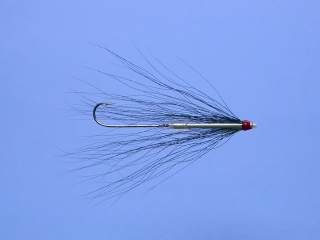 |
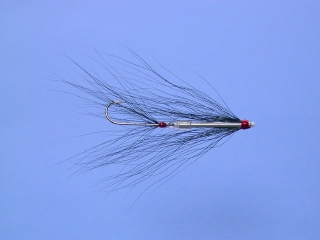 |
|
Black |
Black Tail |
| |
|
|
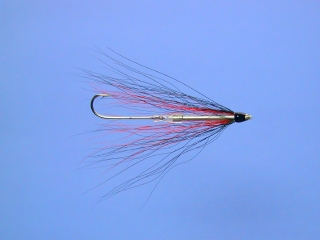 |
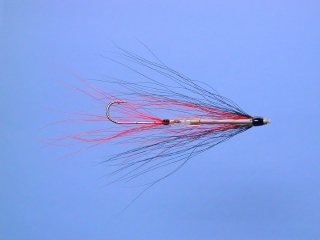 |
|
Black & Orange |
Black & Orange Tail |
| |
|
|
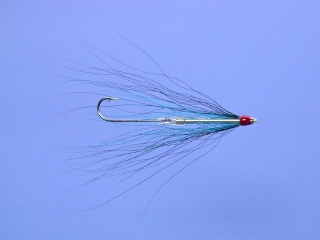 |
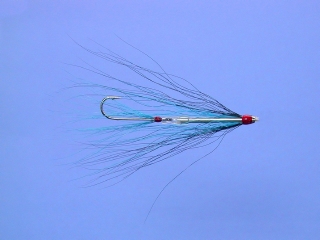 |
|
Black & Blue |
Black and Blue Tail |
| |
|
|
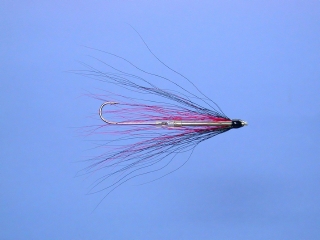 |
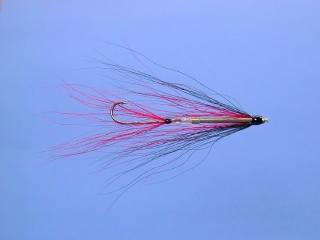 |
|
Black & Red |
Black and Red Tail |
| |
|
|
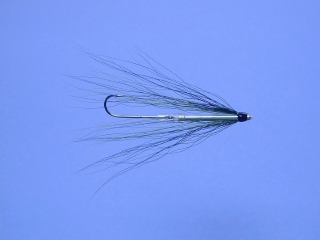 |
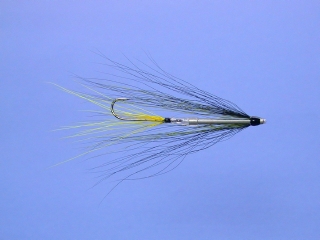 |
|
Black & Olive |
Black & Yellow Tail |
| |
|
|
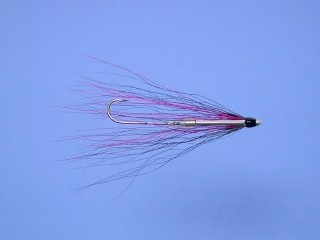 |
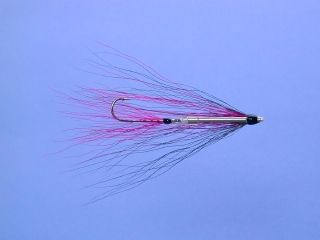 |
|
Black & Magenta |
Black & Magenta Tail |
| |
|
More Tinglers
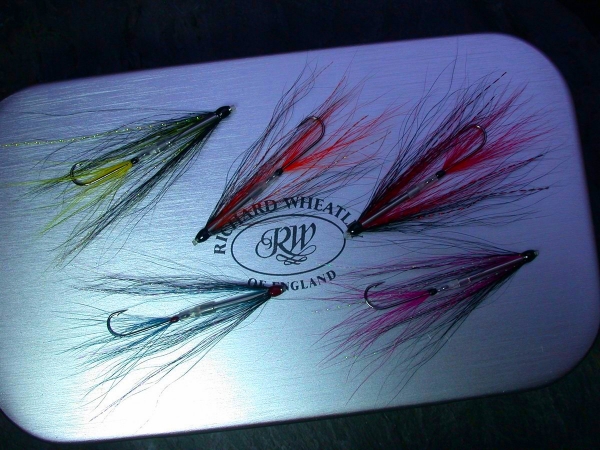
|
The Upturned Hook
Note that the upturned single hook adds to the
balance and stability of the fly, owing to the
fact that a single (or double) undressed hook
will tend to swim naturally with hook points
upwards.
The
photographs below show how an undressed single
hook, or single hook attached to an undressed
tube, will swim when pulled through the water.
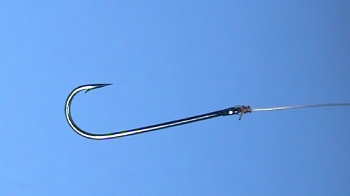
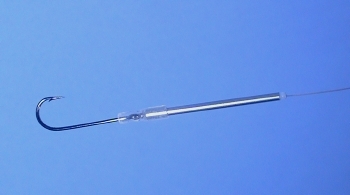
It seems sensible, therefore, to set our single (and double) tube
fly hooks with points uppermost, thus aiding, rather than opposing, the natural
orientation of the hooks, with the following potential benefits:
- Improved stability of the tube fly
- An upturned hook may be more
easily hidden among the hair of the wing and therefore less conspicuous to a
fish
- An upturned hook may be less
easily damaged on a rocky river bed or caught up on riverbed weed
- An upturned hook may reduce the likelihood of hooking leaves
while fishing in the autumn.
|
The Advantages of Single Hooks
The use of a single hook on
a tube fly may offer the following advantages:
1. With the growing awareness of the need to conserve
fragile sea trout stocks, the single hook makes it easier to
release fish quickly and without harm.
2. The use of a long shank, straight-eyed single hook,
either dressed or undressed, allows the length of the lure
to be extended without increasing the weight.
3. The use of a lighter single at the tail end of the tube
allows the lure to swim, possibly more attractively, on a
more even keel, with the bulk of the weight towards the
front of the lure. In addition, a shorter and therefore
lighter tube may be used (where a weighty lure is not
required) in conjunction with a long shank single, which may
be more easily cast on a light single handed rod.
4. A variety of lightly dressed single hooks, in various
materials, densities and shades, may add some mobility and
vitality to the tube fly and variously dressed single hooks
can be readily interchanged with various tube dressings to
create a wide range of colour/shade/shape options. For
example, four tubes and four dressed single hooks, all with
different dressings, give a possible 16 variations of fly,
20 if we include the possible use of an undressed single
hook.
Tinglers
may of course
be dressed in a wide variety of styles, for sea trout,
salmon, steelhead and other predatory species. A few more
Tinglers are shown below, dressed in a different style.
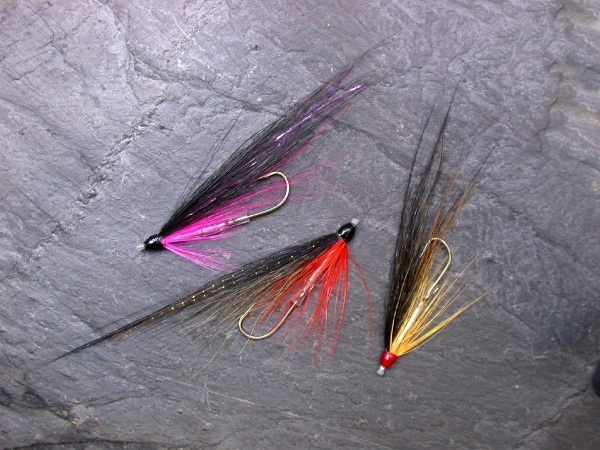
A Sea Trout Taken on
the Tingler, River Spey, 2018
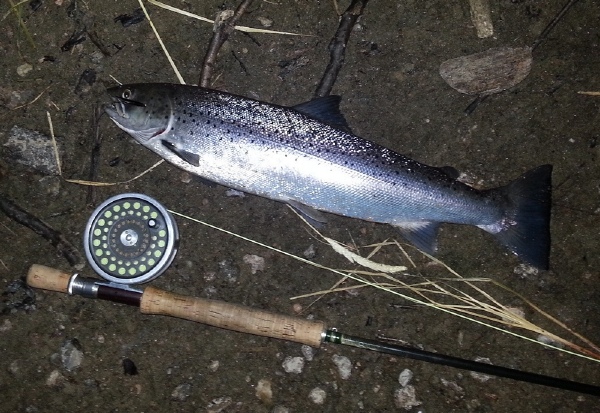
See also
How to make a knot guard (or swing
tube) for a Free Swinging Tube
Fly Hook
Sea Trout Articles |
|